"We can easily forgive a child who is afraid of the dark; the real tragedy of life is when men are afraid of the light." -Plato
Imagine, if you will, the year 2200. Forget about the flying cars and robotic exoskeletons, though. I'm thinking about the incredible scientific tools we'll have at our disposal, as well as the huge set of information we'll have available about the Universe.

One day, the latest telescope project gets completed, and we're finally able to make detailed measurements of an extra-solar planet's surface!
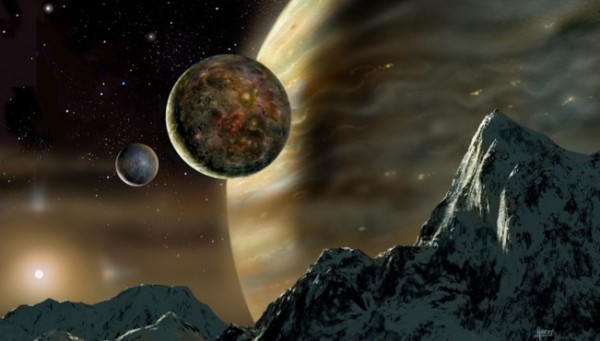
We'd already been able to learn much about this planet, including its temperature (about 20° warmer than Earth), rotational speed (9 hour days), orbit (approximately circular, 0.82 Astronomical Units in radius), and atmospheric composition. Based on our findings, we had believed that it was teeming with life! Imagine we'd even been able to measure the altitude of various features, including finding sea level (and a sea!), as well as mountains, valleys, plateaus and plains.

But we hadn't been able to image it directly, not until now. So we'd made predictions about what type of life we'd find there. We saw an atmosphere with lots of molecular oxygen, with nitrogen and other elements, much like Earth's. We found carbon signatures on the ground and traces of CO2 in the atmosphere, as well as liquid water and water vapor.
Overall, we expected to find life similar to life on Earth, except, with this new planet being hotter, we expected more of the tropical-style plant and animal life. What did the new telescope reveal?

For some reason, this planet, although covered with its own amazing biodiversity, didn't have any angiosperms on it. No leafy, deciduous trees, no flowering plants, nothing, in fact, resembling the lush, forested land our best astrobiologists had expected. The flora, surprisingly, resembled pine trees more than anything else, even in the warmest, wettest, most tropical climates.

But, despite what was immediately dubbed "the angiosperm problem," scientists hailed this as a triumph. With a successful prediction of life, many stages of its evolution, and a large number of specialized adaptations, the astrobiologists were almost completely satisfied.
But there were a small number who were convinced that they had it all wrong. Where were the flowers? Where were the maples? Where were the fruit-bearing trees? Standard Astro-Darwinian theory dictated that they ought to be there! So they created their own, rival theory, Extended Gymnospermic Astro-Darwinism, or EGAD! It still predicted life, and it also predicted gymnosperms outcompeting angiosperms. But it failed to predict many of the things that standard theory predicted, giving incorrect predictions for the adaptations to temperature and altitude, as well as failing to predict the evolutionary timeline correctly. Still, a few scientists could not get past the angiosperm problem, and rather than trying to solve it, abandoned all of the accepted astrobiology in favor of working on EGAD.

This story, of course, is pure fiction, and since I wrote it, there's probably a whole slew of things wrong with the biological assumptions in it.
But right now, in my field of cosmology, the same thing is going on with the dark matter problem. Although I've already told you what convinced me that dark matter exists, I'll briefly recap some of what dark matter explains.

It successfully explains the observed large-scale structure of the Universe. Simulations without dark matter all fail to match the observations, but with dark matter, they match up practically perfectly.
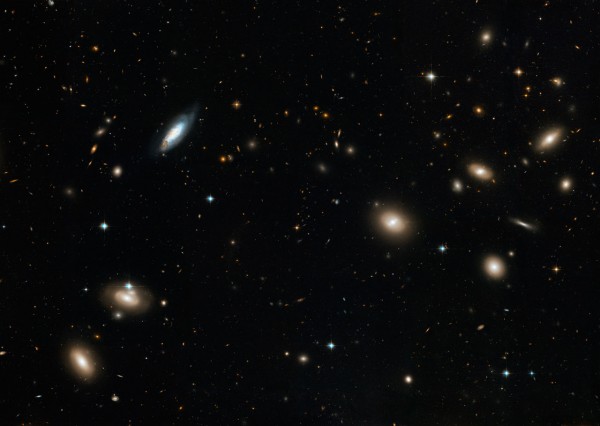
Look at the individual galaxies within any of the many galaxy clusters we see, like the Coma Cluster, above. They're all moving too quickly to be held together by just the gravity from protons, neutrons, and electrons. An extra, dark type of matter must be present in this cluster. Why am I so convinced that it isn't more protons, neutrons, and electrons? Or that the law of gravity just isn't different than we expect?

Because when we look at two colliding clusters, above, we see that gravity (in blue) doesn't line up with where the normal matter is (in pink)!
But that's not all. Without dark matter, there would be a whole mess of things that didn't work out.
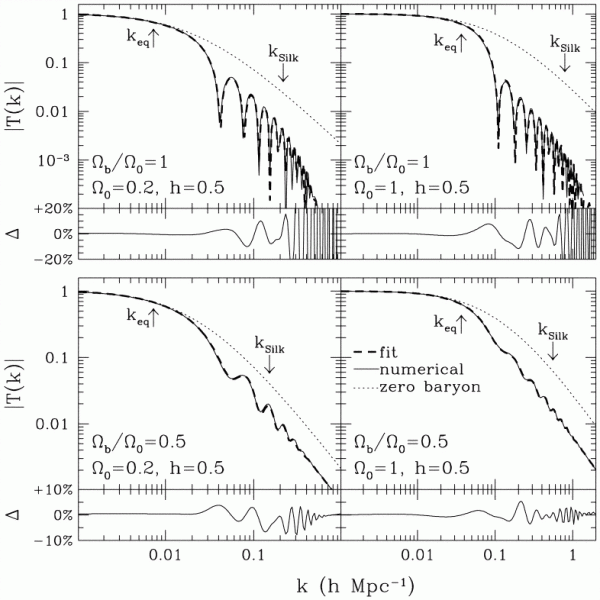
The matter power spectrum of the Universe, for one. (Image from Eisenstein & Hu, 1998.) The top sets, with all of the matter being normal matter (and irrespective of your law of Universal Gravitation), is completely ruled out. But if you allow some of that matter to be dark matter (i.e., not protons, neutrons, and electrons), you get a graph that looks more like the bottom set, which is also what we see in the Universe.
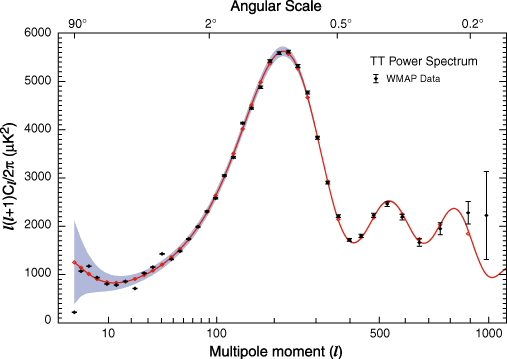
The spectrum of fluctuations in the microwave background is another one! If you look at what you get (data points, above), and compare it with predictions involving dark matter (solid line, above), it lines up pretty well! But if you take the dark matter away, the shape of your curve looks like this.
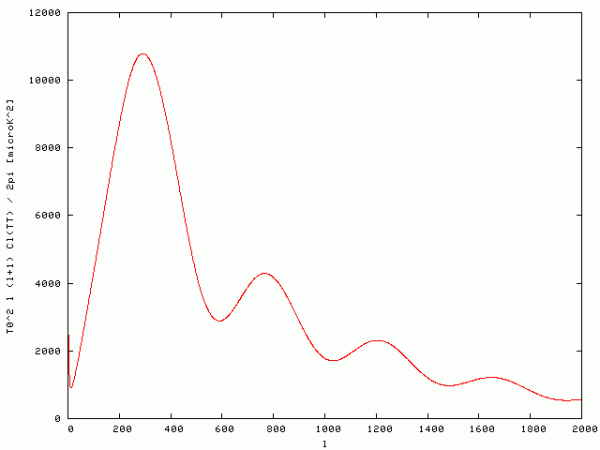
I know, because I calculated it myself! I'll just give you one more.

Without dark matter, you'd need much more normal matter in the Universe in order to make the Universe the way it is. But you can't have any more than we see, because you would screw up big bang nucleosynthesis! The abundance of the light elements is well observed, and consistent with there only being about 6 nucleons (protons and neutrons combined) for every 10 billion photons; try to put more in there and you'll conflict with what we see.
Bottom line, dark matter -- this one addition -- makes these and a whole host of other observations work out. But, much like the fictitious astrobiologists and their predictions of angiosperms, there's one thing that dark matter gets slightly wrong.

For individual galaxies, dark matter predicts a huge, diffuse, massive halo surrounding the galaxy. This should have a gravitational effect, and should cause the galaxy's rotational speed to vary with distance according to either the curve marked "Moore" or "NFW", below.

But it doesn't! It matches the line marked "isothermal." In other words, dark matter is wrong in the details it predicts for individual, galaxy-scale objects. And this is a genuine problem for the theory of dark matter. It's a puzzle that most of us are hoping to work out.
And, as you might expect, just like there were the EGAD group of scientists in the story at the top, there are people in favor of modifying Newton's Laws of Gravity to explain these galaxy-scale features. If you do Modify Newtonian Dynamics (the theory of MOND), you can explain the galactic-scale observations better than dark matter can. But you can't explain any of the others.
Any of them. And the predictions that even simple models make are wildly in conflict with a huge number of observations. So, most of us try to fix the problems with dark matter on galactic scales by studying it better, and trying to figure out what's going on with the halo.

But I am compelled to tell you all of this today. Why? Because over in Germany, one of the most media-visible scientists, Pavel Kroupa, has been harping on the galactic-scale successes of MOND, and touting it as a superior alternative to dark matter. In addition to a number of press releases, he's even started his own blog on the SciLogs network, The Dark Matter Crisis.
His writing is focused on this one issue in many different incarnations: the incorrect predictions of dark matter halos, in the detail of their density profiles, on scales of a single galaxy and smaller.
I'm not saying that there isn't something to be learned from MOND, but I am saying that it isn't a better explanation for anything except the dynamics of an individual galaxy than dark matter. But it was designed to explain the dynamics of an individual galaxy. Until you manage to accomplish something else with MOND, I'm not only going to support dark matter, I'm going to keep you honest about your claims of what MOND does and dark matter doesn't do. It's important to consider alternatives to the standard theories, to be sure, but not to do it at the expense of all of your evidence.
Don't ignore the great forest of evidence, on all of its different scales, just because the individual trees look different than you were expecting. Try to figure out why the trees are different, and try to reconcile that with the fact that they're definitely found in a forest.
- Log in to post comments

Maybe I'm reading this wrong, but doesn't the discrepancy between the current dark-matter model and galactic rotation suggest a weak long-range coupling between dark and electronic matter?
Regarding the two colliding clusters. Being that the normal matter is separating from the dark matter, is there any evidence that the clusters are falling apart due to the weaker binding gravity? Are there other examples of this matter/dark matter separation?
Newtonian gravity calculations are simple and predict the existence of vast amounts of dark matter.
General relativity gravity calculations are difficult but when done correctly show little need for dark matter.
So once again, another quote from Fred I. Coopertock's excellent 2009 book General Relativistic Dynamics, Extending Einstein's Legacy Throughout the Universe,
http://books.google.com/books?id=xH21YVGLWfEC&printsec=frontcover&dq=Ge…
I read pg 155, "We have seen that on the basis of the simple model, the observed Coma Cluster velocities can be rationalized with general relativity applied to only the visible content of the system. While the model is simplified as an idealized perfectly spherical system, and a general relativistic formalism for chaotic systems is yet to be rationalied, this result is further cause to question the pronouncements that have been made concerning supposed vast quantities of dark matter within clusters."
So again I ask; what is wrong with Cooperstock's alternative explanation of galaxy formation without apparent need for dark matter?
Cooperstock summarizes pg 159, "Indeed for the most part, astronomers continue to ignore general relativity in making deductions from their observations. Thus, an industry has arisen of massive computer simulations with billions of conjectured dark matter particles. The claim has been made that these simulations confirm that the CDM (cold dark matter) model of structure formation is in accord with observed structures in galaxy surveys such as the Sloan Digital Sky Survey. However, the basis for these simulations is Newtonian gravity. The lesson from our work is that the best theory of gravity, general relativity, is capable of providing surprises."
A
Ethan, there's not a whole slew of things wrong in your biological scenario, just one: it is based in orthogenesis.
cheers!
Ethan is just happy it wasn't covered in cacti.
One question so, can both be partially right? Can something like MOND coexist with dark matter, as in there's some dark matter, and there's something wrong with our standard view on gravity?
You don't need to make up your own crack-brained notions of biology. They're (you might say) coming of the woodwork. Which is not to say that mainstream biologists have got everything right, or even think they have. Biologists are more tentative about their best working hypotheses than any astronomer about their weakest. It's among their appealing qualities.
Well, if the MOND guys are the heretics, this must be the Anti-Christ: http://arxiv.org/abs/1007.1750
Ethan has completely convinced me that dark matter exists. My confusion lies in whether it really is matter or whether our understanding of gravity is faulty or incomplete. (That "our" is a figure of speech; I don't understand gravity at all.)
It seems to avoid the question to declare dark matter a done deal without evaluating the deeper "matter vs. gravity" question that a number of commenters have raised.
The real power of the dark (M/E) side comes from those endorphins released for even the slightest perceived breakthroughs into the seemingly unfathomable nature of the universe(s?). At one with the universe, here we come again!
(This only makes sense if you've been there.)
Hello Ethan,
thank you very much for mentioning our new blog. We hope you will become a regular reader.
In our blog, we have recently shown that the always-mentioned Bullet Cluster is no proof of the existence of Cold or Warm Dark Matter. Furthermore, galaxy clusters can be explained in modified gravity theories without postulating the existence of exotic dark matter.
There are other results you did not mention. For example, sterile neutrinos (as a kind of Hot Dark Matter) can fit the CMBR power spectrum and are compatible with modified gravity theories, but not with LCDM. Furthermore, comparing structure-formation simulations with and without dark matter would only make sense if the latter incorporate modified gravity. Thus this can not be used as an argument for DM and against modified gravity either.
Unfortunately, your argument that Dark Matter is only one addition is not true. In fact, to make Cold or Warm Dark Matter work we need at least: Dark Matter + Dark Energy + Inflation + Dark Force (telling the dark matter where the baryons are, needed to create the exact shape of the rotation curves). And even with several of those epicycles, DM still has a number of problems. Not only one as you have stated, but many, and they are serious. These begin with the exact shape of rotation curves of galaxies, but there are many other that extend to much larger scales and which can not be explained with the influence of baryon physics.
The (rotating!) disc of satellite galaxies around the
Milky Way, for example, has a size of about 500 kiloparsecs and can not be explained in LCDM. You might also have seen the Nature paper by Peebles & Nusser (2010): the distribution of galaxies in our neighborhood within 8 million pc is not as expected. The velocities of the clusters in the Bullet-Cluster even pose a problem for LCDM, they are too fast. And why is it that almost nobody ever mentions Abell 520, which looks like an Anti-Bullet-Cluster?
We would like to invite you, and everybody else interested, over to our blog to discuss these and other issues related to âThe Dark Matter Crisisâ.
Marcel
Marcel,
You're kidding me, right? You think dark matter is crazy, but your alternative for the Bullet Cluster is Moffat's non-local theory of gravity? In layman's terms, you're more comfortable with saying that mass over here will make a gravitational force over there rather than saying there's a new type of unseen mass?
I mention Abell 520 all the time as more evidence for dark matter (a la the Bullet Cluster), as it's clearly a later-stage merger. Nobody believes that the Bullet Cluster won't someday merge into one large cluster, and that the gas and dark matter won't go through different stages of evolution, separately, before winding up back together. But the alternative theory of gravity you cite freaks me out, because it seems to indicate that you should see the same mismatch of gravity and matter both before and after two clusters collide, which clearly is ridiculous.
You want to bring in a sterile neutrino? (Like the person you refer to, Hongsheng Zhao, does in his paper?) Do you know what we call a sterile neutrino in my cosmology circles? A form of dark matter. So if you're reliant on that, you need your non-physically-motivated theory of gravity and still some dark matter? (Just not as much, and of a different type?) Additionally, your sterile neutrino is many orders of magnitude lighter than the ultra-massive, WimpZilla-style sterile neutrino preferred by particle physicists.
And you don't even address the matter power spectrum of the Universe or nucleosynthesis, which are some of dark matter's greatest successes for matching observations with theoretical predictions.
My objections aren't new; they've been talked about in physics and astronomy departments all over the world for (at least) the last 7 years, and they've been dodged by the very scientists you've referenced in talks all over the world. If you want your alternative to be taken seriously by the majority other scientists, you've got a lot of work left to do.
Yes, dark matter has its problems, but your solution -- trying to make a consistent cosmological picture without dark matter -- is like painting with both arms tied behind your back. I'm glad that you're out there, investigating the alternatives, but you're selling this as a viable alternative to dark matter, which I can't support.
What it looks like you're doing, which I hope you're not, is planning to make this sale (of a Universe with no dark matter) in the public arena. (Because it isn't salable to even a large minority of other cosmologists.) I agree that there are flaws with dark matter, but I challenge you to be equally as honest about the flaws with models that eschew dark matter.
Dear Ethan,
Judging by your response, you have not understood the basics of the scientific argument we are making.
We never stated that "dark matter is crazy" - this is a false rephrasing of our objective tests of the cold or warm dark matter theoretical approach to cosmology.
Also, we are not saying that Moffat's (very interesting) nor Milgrom's (also very interesting) approaches are the final answer. As every informed physicist (as Dr. HongSheng Zhao is, by the way!) ought to know: within the gravitational community it is perfectly understood that neither MOND nor MOG are the final theory of everything.
What is a fact though is that MOND in particular is by far more superior for describing galactic dynamics - galaxies are MONDian objects, they are definitely not "Newtonian plus cold or warm dark matter" objects (or if they were, then a new unknown "dark force" would need to be invoked to tell the dominant dark matter to do exactly what the little bit of normal matter is doing).
The scientific hypothesis we have been investigating is: keep Newtonian dynamics. This logically requires the postulate of the existence of cold or warm dark matter (to explain rotation curves and galaxy clusters).
This is a valid scientific step to do and to test. But, it does not work. It does not work on all the problems tested. Full stop!
Arguments that the hypothesis leads to nice agreement with some data e.g. nucleosyntheis (but it actually doesn't), or large-scale structure are irrelevant if the hypothesis fails anywhere. And it fails really badly, as we have shown in our peer-reviewed research paper. And this failure is not an issue of not understood small-scale problems with the physics.
A scientific theory can never be proven, independent of how well it is shown to work by some data. If it fails in a certain regime, it is dead.
But, a falsified scientific theory can be continued to be used to do simplified calculations. For example we keep on using Newtonian dynamics in the Solar System although Newtonian dynamics has been superceded by General Relativity as a more successful mathematical description of reality. One can even today use the epicyclic model to perfectly well describe the motions of the planets. Or, locally, you can assume the Earth is flat.
Ours is not a "sale in the public arena". We have been explicitly asked, by the educated public sector in Germany, to develop our blog on SciLogs, which is based on our invited article in Spectrum der Wissenschaft (which is similar to Scientific American). The reason for this is that fundamental scientific research is paid for by the tax payer, and the interested tax payer ought to learn about the current state of research in one of the most fundamental problems in present-day physics.
The fact that we have a paradigm shift is important for the society to know. In two weeks time (on August 18) we will put up a blog on SciLogs with the title "The Zwicky Paradoxon: the fourth failure of Newton (MOND, MOG, etc)", where we show that the currently discovered failure of Newton's laws in the regime where space-time curvature is very small is but the fourth such case. One such failure of Newton implies that particles can "magically" appear at a place where Newton would not have allowed them to. A physicist stating this may be referred to as being nuts, but tunneling is in fact an established physical process of quantum mechanics which also happens to be quite fundamental to important technologies we are using without even being aware of it. That is, it is already a tradition in physics that Newtonian mechanics and dynamics fails in physical regimes far removed from our daily experience, and in each case fundamentally new physical concepts and theories have arisen leading to a significant improvment of our understanding of reality.
This understanding ultimately propagates, after many decades, through to the technological sector, as it has in the previous 3 failurs, where it led to planet-wide industries the worth of which lie in trillions of dollars (e.g. telecommunication, navigation systems, computer systems). And surely the public is interested in the process of how this occurs.
Pavel Kroupa, Marcel Pawlowski and Anton Ippendorf
i wonna know more about science.
truly science has improve our human nature,why am i saying this,without science it will be difficult for us to understand nature and its purpose of existing.all my interest involve scientific theory and its phenomenon chemist.
Some years ago I came across a mathematical model that may be relevant to the physical world. My own research related to new methods in the field of artificial intelligence with which I dealt earlier in my career. The situation there with respect to the modeling of intelligent behavior is roughly comparable to that one physicist are confronted with. Increasingly powerful computers with huge processing and memory resources hide merely the fundamental problem of the discipline: For more than twenty years now, there is no substantial progress in the understanding of intelligent behavior.
But what does this have to do with physics? Now - it's just the case that nowhere you can assume a rigid boundary that distinguishes intelligent behavior. No matter where you move it: you will realize that beyond the arbitrary drawn line this phenomenon most likely still exists. Thus, the unbiased hypothesis is that some basic principles of intelligent decision-making must be observable at each scale. It is a matter of perception and the definition of the phenomenon (for intelligence and consciousness, there is no universally accepted definition, so that scientists here still enjoy great freedom).
In short - a model for intelligent behavior should be applicable down to some physical effects. Following that idea the model implements a swarm of software agents that shows amazing properties in the simulation. In an external view (the swarm formation, if you will), it behaves exactly as one would expect in the measurement of the spin of an electron. After applying some sort of tension to the swarm, which is determined by an operator, its formation after some time falls into one of two states. Which one gets selected is based on chance and the probabilities can be calculated exactly from the initial state of the swarm and the symmetry properties of the operator.
The swarm individuals meanwhile undergo a random process - similar to a Brownian motion - throughout this âmeasurementâ. The dynamics on position averages can be described with the mathematical tools of general relativity (Euler-Lagrange toolset to handle curved space time).
Actually some sort of such a model may indeed be relevant for physics. The point is that one must accept our universe â from a quantum mechanical point of view â to behave according to a measurement process. As an extension of the Copenhagen standard model, this special one lets the QM completely untouched. The general theory of relativity then applies to the averages of all movements. The model suggests that it may hold precisely only in the vicinity (whatever that means exactly) of masses. It would at least be interesting to assess, whether such an approach reduces or eliminates the need for dark matter / energy.
And by the way I would get confirmed to be on the right track with modeling intelligent behavior in a very different way.
Regarding the model, there is a mathematical paper, "Dual Reality" and the mentioned simulation in place. Both can be found on the page http://bzus.de/ above.
I don't doubt that there is an unsourced gravity which holds galaxies and galactic clusters together. I have some concerns over confirmation bias in assembling the models for what could cause this unsourced gravity and that a type of reverse engineering the mechanics of galactic gravity can lead to incorrect conclusions.
Right now a particle-based dark matter theory is asking me to accept a model that:
1) Is comprised of no constituents of the standard model
2) Produces gravity without any stress-energy tensor components
3) Has never had any gravitational influence on any orbiting system smaller than galactic scale.
What I want from physics is a recognition of these three problems and a model that corresponds accordingly to explain these inconsistencies. The idea of a particulate halo of matter that is also in exemption of the preceding three conditions are at odds with what we know about physics. I dare say they stand at odds with even a means to test for it. To someone like me I see a reflection of the luminiferous ether in the proposal of a particulate dark matter model.
Now I am not qualified to suggest a replacement to this model, but I am trying to reach out to people who are. I don't have a mathematical model but I am prepared to present a mechanism. I don't think this model is falsifiable experimentally but if it is wrong I think it can be disproved mathematically.
At the center of all galaxies are black holes. What if our fundamental understandings of these black holes was wrong? What if Matter is excluded from inside these black holes by spacetime dilation? What if that dilation inverts the spacatime below the event horizon? What if rather than massive singularities the origins inside black holes were mathematical singularities? What if these spacetime throats were not one per black hole but in a multitude in correspondence with quantum fluctuations? What if these spacetime throats formed Einstein Rosen bridges between the galaxies?
Here are two simple videos that outline my hypothesis:
https://www.youtube.com/watch?v=jNqOnpWjBx8
https://www.youtube.com/watch?v=VxAbXmXkaR4
@BenSteb #16: It seems that you have a limited and misdirected understanding of dark matter. You wrote,
"Right now a particle-based dark matter theory is asking me to accept a model that:
1) Is comprised of no constituents of the standard model
2) Produces gravity without any stress-energy tensor components
3) Has never had any gravitational influence on any orbiting system smaller than galactic scale."
1) The Standard Model is known to be incomplete. The three most common candidates for particular dark matter are either known (neutrinos) constituents of the Standard Model, or well-predicted (axions) or proposed (supersymmetric particles) extensions to it, which are well motivated by theory.
2) Mass produces gravity. All of the proposed candidates for particulate dark matter are massive, and therefore produce gravity. "Stress-energy tensor" is just a fancy, relativistic way of saying "mass" in this context, and does not add any useful information content.
3) Density. If you actually have the knowledge of physics you're claiming, then it should be straightforward for you to compute the total mass of a (assume spherical) dark matter halo necessary to produce the flat part of a galaxy's rotation curve. From the mass and volume, you can trivially compute the density. Then use that density to compute the contribution to the mass of, let's say, the Solar System. Please reply to this post with your result.
To Mikey the SLACer #17:
You wrote “Mass produces gravity.”
This made me think of something Ethan recently wrote:
“…the mass in stars gives you a number, and the *mass from gravity* gives you a greater number. Not a number greater by a little bit, either: one that was bigger by a factor of fifty.”
Would you explain the difference between
a) mass in stars/planets/objects and
b) “mass from gravity”?
Yes, there seem to be 129 such videos. It might be time to advance to the "shut up and calculate" part of things.
^ It is amusing, though, that S.N. tried to attention-leech off of the necromancing of a five-year-old post purely for the sake of again demonstrating wholesale failure in the "reading comprehension" department.
Maybe somebody at Breitbump will post your epistle to Jason for you, sad sack.
^^ Please imagine that I closed the italics after "is."
@Deceiver #18: I have a better idea. Why don't you get yourself an undergraduate (freshman will be sufficient) physics textbook, and work it out for yourself. You don't even need calculus for a simple problem.
If you can't understand basic science, then you aren't in any position to ask intelligent questions. Not that that ever stopped you in the past.
1) Complete or incomplete, the standard model is all we have to work with currently and nothing so far presented has fit the bill for a dark matter candidate. Neutrinos are very light, move very fast and over time would spread very thinly emptying the stability of so called dark matter Halos, also if Neutrinos are the dark matter then they, being fermions would correspond to the stress energy tensor and we would see Pressure and density fluctuations that correspond to the Einstein Field equations. We currently estimate that neutrinos make up only a fraction of the universe, smaller even when compared to atomic matter. Axions have recently been discredited as a Dark matter candidate and as for sparticles all of the work is still left to go on that front before we can even consider a mechanism for a dark matter function.
2) According to the Newtonian, the answer is as simple as mass. For the EFE all the nuance is borne out of the idea of matter. The stress energy tensor is more than mass it also incorporates energy and fluctuation it represents what we are certain definitely results in gravity. When you want to say there is a dark matter that is producing gravity, we can break down every attribute which produces gravity. Do we see any of them in these dark matter haloes? If we don't and we're seeing none of the attributes of matter why are we calling it matter.
3) Please post with your reply of any time any orbiting star system or planetary system or any basic orbital system is ever changed from its expected orbit by a gravitational source that could only be attributed by an exclusive dark matter interaction. We know the density of dark matter varies as we measure from galactic center where's the push and pull on the orbiting stars and planets? Does dark matter simply not churn even as the galaxy spins? Am I never to expect any orbits of any stars or planets to ever be influenced by the particles that produce three quarters of the gravity in the universe?
Something is going on that we have no idea about. What I meant when I posted these three conditions was to show that Dark matter models that have been suggested fly in the face of the standard model, the Einstein Field Equations and everything we expect to see from orbiting bodies going back to Newton. A previous analog to dark matter was the mysterious vulcan planet that was tugging at Mercury changing its orbit. That planet turned out to be not a planet at all but a result of relativity, which simply replaced the previous theory. I have seen no convincing particle models for this but by my estimation the particle physicists had a hammer and galactic rotation curves looked like a nail to them. I'd like you to start coping with the possibility that you're dealing with a screw. There was no Lumineferous ether, there was no planet vulcan. The practice of declaring a new object or substance not out of process of elimination or closer scrutiny but out of ignorance of the next scientific revolution is not new to physics, but it rarely produces lasting results.
Ben, I strongly suggest that you lay off of repeating the word "we," although the minor refinement ultimately provided by use of "them" is of course appreciated.
"One question so, can both be partially right? Can something like MOND coexist with dark matter, as in there’s some dark matter, and there’s something wrong with our standard view on gravity?"
Well, yes.
But it still requires Dark Matter, and since there's no actual bound on the modification to Newtonian Dynamics, you can't really do anything about finding THAT until *after* you've put some theory behind the dark matter and observed its effects so as to describe its distribution.
Thing is, MONDers insist that it's MOND. No DM.
DM *can* answer the entire problem. For example, if DM interacts via the weak nuclear force strongly, then neutrinos can impart high amounts of momentum to dark matter and cause it to be slightly ejected from the undisturbed orbits either outward (if the interaction is elastic collision) or inward (if its inelastic attraction).
MOND can't do it, unless it has a huge number of predicate clauses and realms of application for those clauses. Which we'd have to explain as to WHY these are the rules.
WS your opening paragraph SAID NOTHING AT ALL.
Please attempt some more rigour in your posts so that someone can see if there's liable to be something worth reading in the rest of the post, since your opener indicated that the rest would be empty of substance (as indeed it was: there is, though, the possibility that your opening paragraph primed me to see the vacuous and ignore any grains within, hence the need to tighten up your prose).